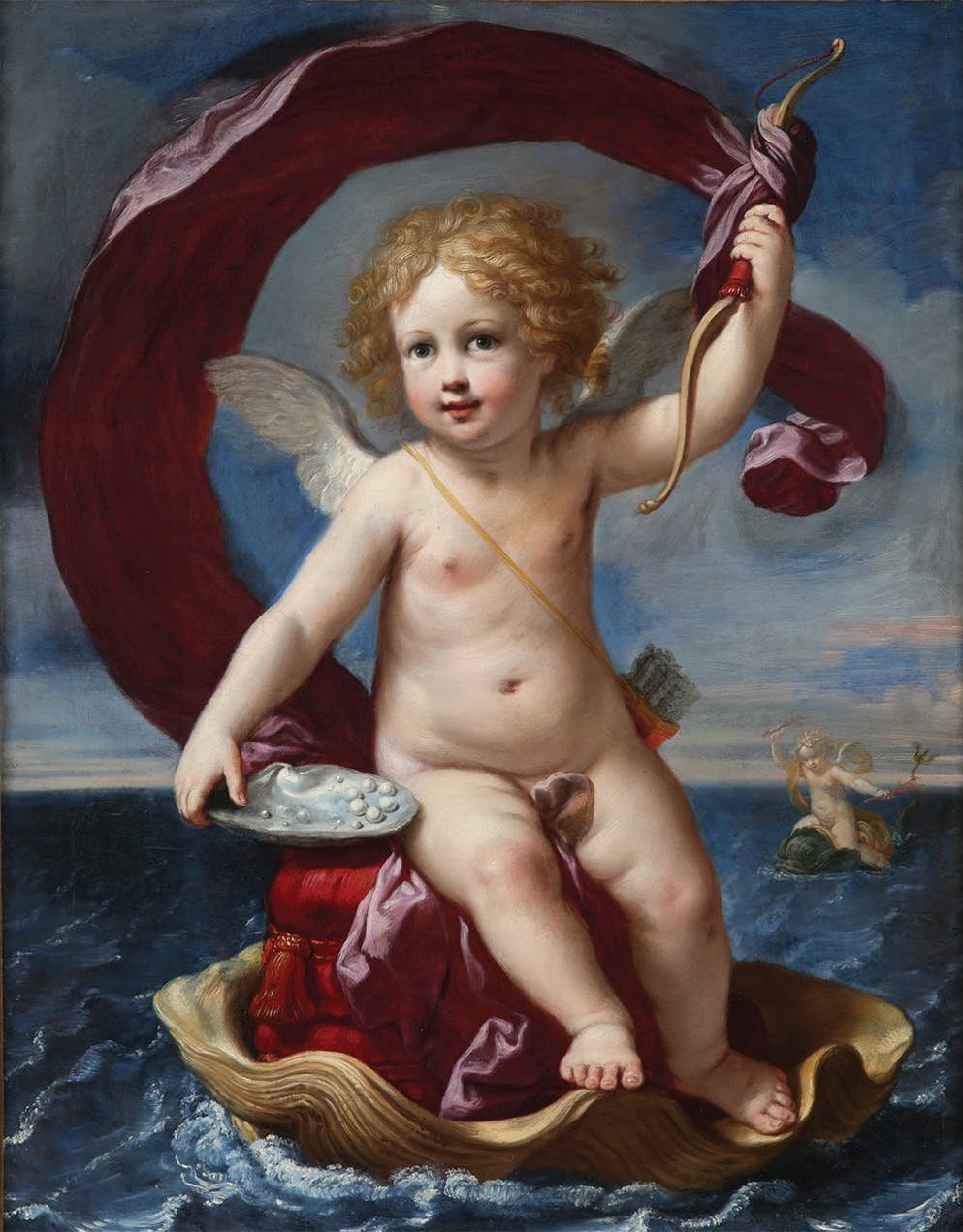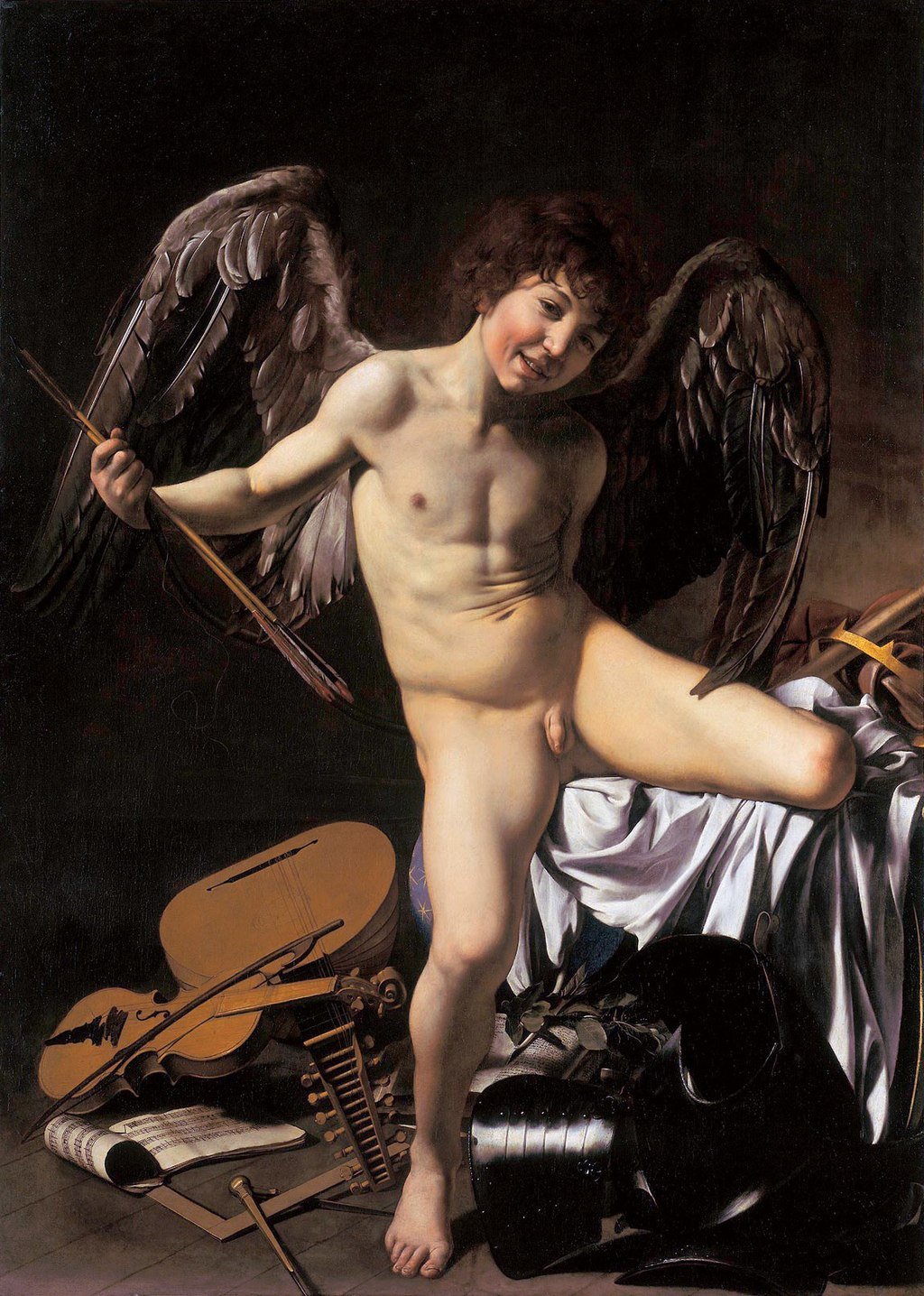ELISABETTA SIRANI
(Bologna, 1638 – 1665)
Omnia Vincit Amor (Love Conquers All)
Signed and dated, lower center: ELISAB.TA/ SIRANI F/ 1662
Oil on canvas
33 x 27 inches (83.7 x 68.6 cm)
Provenance:
Commissioned by Padre Giovanni Vincenzo Paolini, 1662
Camillo Hercolani, Bologna, before 1677;[i] by descent to:
Principe Filippo Hercolani, Bologna, by 1713; by descent to:
Astorre Hercolani, Bologna, until sold 5 May 1836
Saul Cohen, Rockville, Connecticut
Christie’s, New York, 3 October 2001, lot 47; where acquired by:
Galleria Cantore Antiquaria, Modena, 2001–2004; from whom acquired by:
Private Collection, Piacenza, Italy, 2004–2023
Exhibited:
“La donna nella pittura italiana nel Seicento e Settecento: il genio e la grazia,” Museo di Arti Decorative of the Fondazione Pietro Accorsi, Turin, 28 March – 27 July 2003, no. 86.
“Elisabetta Sirani: “Pittrice Eroina,” 1638–1665,” Museo Civico Archeologico, Bologna, 4 December 2004 – 27 February 2005, no. 99.
“Di Mano donnesca, donne artiste dal XVI al XX secolo,” Palazzo Venezia, Rome, 4 – 14 October 2012.
“Il visibile narrare: Storie di Dei e Uomini nella Collezione Cantore,” Galleria Comunale d’Arte, Cesena, 1 December 2013 – 26 January 2014, no. 16.
“Elisabetta Sirani: Donna Virtuosa, Pittrice Eroina,” Galleria PBER Banca, Modena, 17 September – 14 November 2021, no. 6.
Literature:
Carlo Cesare Malvasia, “Nota delle Pitture fatte da me Elisabetta Sirani,” in Felsina Pittrice: Vite de’ Pittori Bolognesi, Bologna, 1678 (ed. Giampietro Zanotti, 1841), vol. 2, p. 397
Jacopo Alessandro Calvi, Versi e Prose sopra una serie di eccellenti pitture possedute dal Sig. Marco Fil. Hercolani, Principe di S.R.I., Bologna, 1780, pp. 62-63.
Petronio Bassani, Guida agli amatori di Belle Arti, architettura, pittura, es cultura per la città di Bologna, Bologna, 1816; cited by Modesti, 2014, p. 308.
Emilia Calbi, Daniela Scaglietti Kelescian, and Marcello Oretti, Marcello Oretti E Il Patrimonio Artistico Privato Bolognese, Bologna, Biblioteca Comunale, Ms. B. 104, Bologna, 1984, p. 176 [ms. B 104, I, c. 136].
Adelina Modesti, “Alcune riflessioni sulle opere grafiche della pittrice Elisabetta Sirani nelle raccolte dell’Archiginnasio,” L’Archiginnasio, vol. 96 (2001), pp. 195-196, note 124, fig. 56.
Franco Paliaga, in La donna nella pittura italiana nel Seicento e Settecento: il genio e la grazia, ed. Alberto Cottino, exh. cat., Turin, 2003, pp. 210-211, cat. no. 86.
Armando Audoli, “Passioni e Tormenti Barocchi,” in Grazia, no. 49 (6 December 2004), p. 116.
Irene Graziani, in Elisabetta Sirani: “Pittrice Eroina,” 1638–1665, ed. Jadranka Bentini and Vera Fortunati, exh. cat., Bologna, 2004, pp. 241-242, cat. no. 99.
Adelina Modesti, Elisabetta Sirani: Una virtuosa del Seicento bolognese, Bologna, 2004, pp. 39 note 89, 128-129, 327 note 99, fig. 66.
Barbara Ghelfi, “Un nuovo inventario della galleria Hercolani nella Biblioteca dell’Archiginnasio,” L’Archiginnasio, vol. 102 (2007), p. 446.
Consuelo Lollobrigida, in Di mano donnesca, donne artiste dal XVI al XX secolo, exh. cat., Rome, 2012, pp. 16-19, fig. 9.
Floriana Conte, “Nota a margine del Ritratto di Vincenzo Ferdinando Ranuzzi di Elisabetta Sirani con qualche riflessione sugli Amori,” Iconographica, vol. 12 (2013), pp. 186-189, fig. 4.
Daniele Benati, in Il visibile narrare: Storie di Dei e Uomini nella Collezione Cantore, ed. Alessandro Giovanardi, exh. cat., Cesena, 2013–2014, p. 82, cat. no. 16.
Adelina Modesti, Elisabetta Sirani ‘Virtuosa’: Women’s Cultural Production in Early Modern Bologna, Turnhout, 2014, pp. 307-308, cat. no. 86.
Lucia Peruzzi, Elisabetta Sirani: Donna Virtuosa, Pittrice Eroina, exh. cat., Modena, 2021, pp. 36-37, cat. no. 6.
Adelina Modesti, Elisabetta Sirani, Los Angeles, 2023, p. 137.
Famously described by Carlo Malvasia as “the glory of the female sex, the gem of Italy, the sun of Europe,” Elisabetta Sirani enjoyed great renown across Europe for her prolific talent and reputed beauty. Daughter of Giovanni Andrea Sirani (1610–1670), Guido Reni’s principal assistant, she had begun painting by the age of 17, most likely training under her father, since as a woman she would not have had access to an academy. Sirani worked principally for private aristocratic and ecclesiastic patrons, producing small-scale devotional works, as well as larger religious and historical pictures. She also executed altarpieces for major churches in and around her native city of Bologna. Upon her early death in 1665, aged just 27, she was immortalized in a series of poetic eulogies in which she was variously described as a “miracolo del Mondo” (“miracle of the world”), a female Apelles, even a Phoenix, the mythical bird who was continually reborn.[ii]
Depictions of children were favorite subjects for Sirani—perhaps a surprising focus for an artist who never married or had children. Whether painting the Christ Child, the Infant Saint John the Baptist, allegorical figures, angels, or Cupid, Elisabetta imbued these figures with a combination of seriousness and playfulness. The present work is arguably the most important treatment of such a subject in Sirani’s oeuvre. It is an elaboration of the artist’s earlier composition Cupid Triumphant on the Sea of 1661, which Sirani painted on three occasions—first for the wedding of Cosimo III de’ Medici to Margherita Luisa d’Orléans (Fig. 1), and subsequently in versions for the Cordini and Rizzardi families.
Fig. 1. Elisabetta Sirani, Cupid Triumphant on the Sea, oil on canvas, Private Collection, Bologna.
Our painting returns Cupid to land and places him in a landscape seated against crimson drapery. Omnia Vincit Amor is identifiable in Sirani’s own list of her works published by Malvasia in his biography of Bolognese artists, Felsina Pittrice: “A Cupid sitting on red drapery, which acts as a backrest, with his right hand he gestures to some books, holding a scepter and laurel crown in his left hand; for the Father Inquisitor.”[iii]
Adelina Modesti identified Sirani’s patron, the Inquisitor General of Bologna, as Padre Giovanni Vincenzo Paolini da Garessio. While the patron’s vocation undoubtedly influenced the iconography of the painting, there are no overtly religious references in the composition. In fact the subject derives from a well-known classical source, a passage in Virgil’s Eclogues (X, 69): “Omnia vincit Amor et nos cedamus Amori” or “Love conquers all; let us all yield to love.”
This passage was earlier (and famously) taken up as a subject by Caravaggio in the first years of the 17th century (Fig. 2). His Amor Vincit Omnia rapidly became the object of both praise and controversy in Rome, having given rise to both laudatory poems and virulent criticism, most notably from the artist’s rival Giovanni Baglione.
Fig. 2. Caravaggio, Amor Vincit Omnia, oil on canvas, Gemäldegalerie, Berlin.
Sirani was no doubt aware of Caravaggio’s celebrated painting, as she similarly depicts Love triumphant over earthly endeavors, symbolized by a variety of objects scattered across the composition. However her conception of the central figure was quite diverse. In contrast to Caravaggio’s sexualized youth, Sirani’s Cupid is a robust child, his nudity emblematic of virtue and innocence.[iv] She portrays a joyful winged Cupid, naked but not lurid, engaging directly with the viewer as he proudly demonstrates the superiority of love over earthly pursuits. These include erudition, as represented by the jumble of books (one of which is inscribed “PLI[NY]”); military ambitions, signified by the bow at lower right and the quiver full of arrows upon which Cupid rests his foot; and the arts, symbolized by the laurel wreath wrapped around the scepter held aloft by the triumphant child.
Our painting passed from its first owner, Giovanni Vincenzo Paolini, to Camillo Hercolani, who was himself close to the Sirani family (having been a witness at the wedding of Barbara Sirani, Elisabetta’s younger sister).[v] It then descended through the main branch of the Hercolani family, where it became the subject of a poem written for the wedding celebrations of Principe Filippo Hercolani and Marchese Corona Cavriani in 1713 (published by Jacopo Alessandro Calvi along with a description of the painting in his Versi of 1780). In the 18th century the Bolognese scholar and collector Marcello Oretti had seen and recorded our painting in the “Casa Hercolani Senatoria dai Servi.” He was the first to call the painting “L’Amore Divino,” or Divine Love, a title by which it frequently appears in the scholarly literature. The painting later hung in the Palazzo Hercolani on the Strada Maggiore in Bologna, now the seat of the University of Bologna, until its sale in 1836.
No drawings by the artist can be associated with the present painting. However, an insight into Sirani’s development of the composition can be had through a pentimento perceptible upon close inspection along the proper left arm of the figure. There a first idea for a bow held by Cupid can be seen beneath the scepter and laurel wreath that we see today.
[i] Upon Camillo’s death in 1677, the painting next passed to his wife Anna de Giacomi. According to his inventory of 2 December 1677, he owned an Amore as well as an Amorino by Elisabetta Sirani (nos. 6 and 7). See: Adelina Modesti, Elisabetta Sirani: Una virtuosa del Seicento bolognese, Bologna, 2004, p. 39, note 89.
[ii] “La poesia muta celebrata dalla pittura loquace. Applausi di nobili ingegni al pennello immortale della Sra. Elisabetta Sirani pittrice bolognese,” 1666. See: Babette Bohn, “Il Fenomeno della Firma: Elisabetta Sirani,” in Elisabetta Sirani. “Pittrice Eroina” 1638–1665, exh. cat., Museo Civico Archeologico, Bologna, 2004-2005, pp. 113-114.
[iii] Carlo Cesare Malvasia, “Nota delle Pitture fatte da me Elisabetta Sirani,” in Felsina Pittrice: Vite de’ Pittori Bolognesi, Bologna, 1678 (ed. Giampietro Zanotti, 1841), vol. 2, p. 397. “Un Amorino, che sedendo sopra un panno rosso, che gli fa ancora il postergale, con la destra mano cenna ad alcuni libri, tenendo nella sinistra scettro e corona di lauro, per il Padre Inquisitore.” Sirani did not differentiate between the years 1662 and 1663 in her list of works. This painting has previously been published as dating from 1663 in the scholarly literature, but the date in the signature clearly reads “1662.”
[iv] A small veil was added to cover the figure’s loins sometime after the completion of the painting and was removed during its recent cleaning.
[v] The painting is recorded as no. 2024 in inventory of the Galleria Hercolani.



